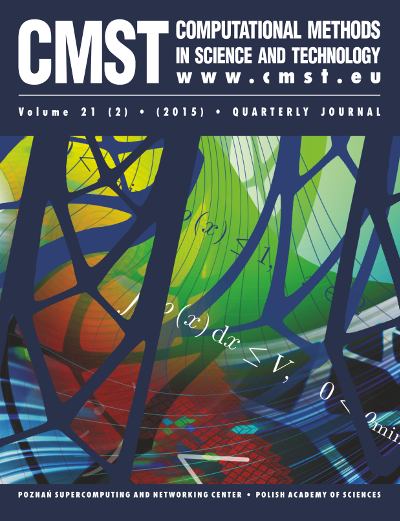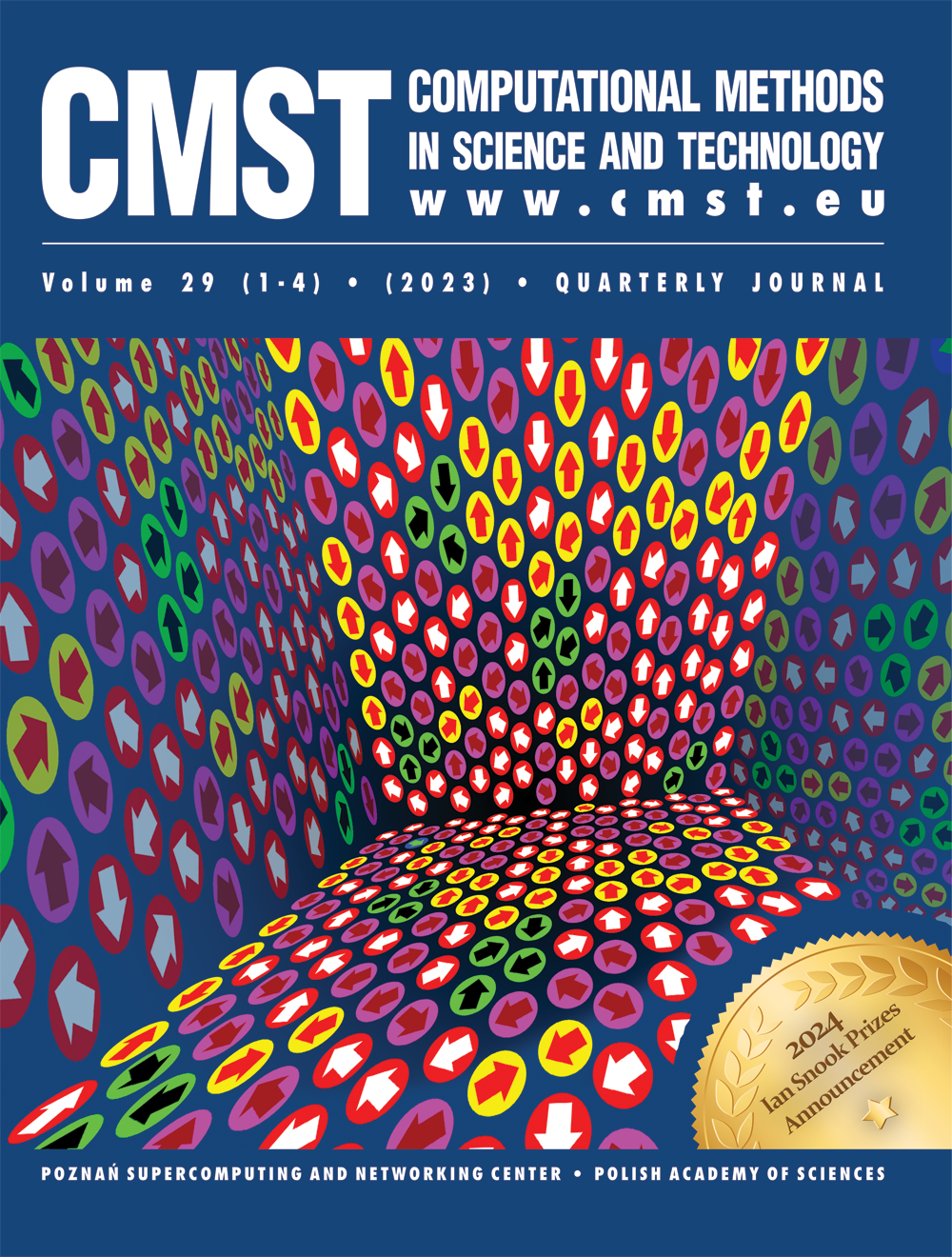EXPONENTIALLY CORRELATED GAUSSIAN FUNCTIONS IN VARIATIONAL CALCULATIONS. THE EF 1E*g STATE OF HYDROGEN MOLECULE*
Komasa Jacek 1, Cencek Wojciech 2
1 Quantum Chemistry Group, Department of Chemistry, A. Mickiewicz University
Grunwaldzka 6, 60-780 Poznań, Poland
2Department of Physics and Astronomy, University of Delaware, Newark, DE 19716, USA
Received:
Rec. 19 February 2004
DOI: 10.12921/cmst.2003.09.01.79-92
OAI: oai:lib.psnc.pl:553
Abstract:
The Born-Oppenheimer (BO) potential energy curve, the adiabatic and the relativistic
corrections for the EF state of the hydrogen molecule are calculated for the internuclear distances ranging from 0.01 to 20 bohr. 600-term variational expansions of exponentially correlated Gaussian (ECG) functions are used. The BO energies and the adiabatic corrections are more accurate than previously reported and the relativistic calculations confirm existing literature values.
References:
[1] T. E. Sharp, Atomic Data 2, 119 (1971).
[2] E. R. Davidson, J. Chem. Phys. 33, 1577 (1960).
[3] W. Kołos and L. Wolniewicz, J. Chem. Phys. 50, 3228 (1969).
[4] J. W. Liu and S. Hagstrom, Phys. Rev. A 48, 166 (1993).
[5J L. Wolniewicz and K. Dressier, J. Chem. Phys. 82, 3292 (1985).
[6] L. Wolniewicz and K. Dressier, J. Chem. Phys. 100, 444 (1994).
[7] L. Wolniewicz, J. Chem. Phys. 109, 2254 (1998).
[8] T. Orlikowski, G. Staszewska, and L. Wolniewicz, Mol. Phys. 96, 1445 ( 1999).
[9] W. Cencek, J. Komasa, and J. Rychlewski, Chem. Phys. Lett. 246, 417 (1995).
[10] W. Kutzelnigg, Z. Phys. D 11, 15 (1989); 15, 27 (1990).
[11] A. Rutkowski, J. Phys. B 19, 149 (1986); 19, 3431 (1986); 19, 3443 (1986).
[12] M. Born and K. Huang, Dynamical Theory of Crystal Lattices, Oxford University Press, New
York, 1956.
[13] N. C. Handy, Y. Yamaguchi, and H. F. Schaefer III, J. Chem. Phys. 84, 4481 (1986).
[14] W. Kutzelnigg, Mol. Phys. 90, 909 (1997).
[15] J. Rychlewski, Electron Correlation in Few-Electron Systems, in Handbook of Molecular Physics and Quantum Chemistry (edited by S. Wilson) John Wiley & Sons Ltd, 2003, Vol. 2, p. 199-218.
[16] J. Rychlewski and J. Komasa, Explicitly correlated functions in variational calculations, in:
Explicitly Correlated Wave Functions in Chemistry and Physics (edited by J. Rychlewski) Kluwer
Academic Publishers, Dordrecht (2003), p. 91-147.
[17] S. F. Boys, Proc. Roy. Soc. A 258, 402 (1960).
[18] K. Singer, Proc. Roy. Soc. A 258, 412 (1960).
[19] B. Jeziorski and K. Szalewicz, Phys. Rev. A 19, 2360 (1979).
[20] M. J. D. Powell, Comput. J. 7. 155 (1964).
[21] J. Komasa and A. J. Thakkar, Mol. Phys. 78, 1039 (1993).
[22] J. Rychlewski, W. Cencek, and J. Komasa, Chem. Phys. Lett. 229, 657 (1994).
[23] W. Cencek and W. Kutzelnigg, J. Chem. Phys. 105, 5878 (1996).
[24] R. D. Bardo and M. Wolfsberg, J. Chem. Phys. 68, 2686 (1978).
[25] W. Cencek and W. Kutzelnigg, Chem. Phys. Lett. 266, 383 (1997).
[26] E. Ottschofski and W. Kutzelnigg, J. Chem. Phys. 106, 6634 (1997).
[27] H. A. Bethe and E. E. Salpeter, Quantum Mechanics of One- and Two-Electron Systems, Springer-Verlag, Berlin and New York (1957).
[28] R. Franke and W. Kutzelnigg, Chem. Phys. Lett. 199, 561 (1992).
[29] http://www.phys.uni.lorun.pl/ftp/publications/ifiz/luwo/EF_e_h98.
[30] http://www.phys.uni.torun.pl/ftp/publications/ifiz/luwo/rel98.
The Born-Oppenheimer (BO) potential energy curve, the adiabatic and the relativistic
corrections for the EF state of the hydrogen molecule are calculated for the internuclear distances ranging from 0.01 to 20 bohr. 600-term variational expansions of exponentially correlated Gaussian (ECG) functions are used. The BO energies and the adiabatic corrections are more accurate than previously reported and the relativistic calculations confirm existing literature values.
[1] T. E. Sharp, Atomic Data 2, 119 (1971).
[2] E. R. Davidson, J. Chem. Phys. 33, 1577 (1960).
[3] W. Kołos and L. Wolniewicz, J. Chem. Phys. 50, 3228 (1969).
[4] J. W. Liu and S. Hagstrom, Phys. Rev. A 48, 166 (1993).
[5J L. Wolniewicz and K. Dressier, J. Chem. Phys. 82, 3292 (1985).
[6] L. Wolniewicz and K. Dressier, J. Chem. Phys. 100, 444 (1994).
[7] L. Wolniewicz, J. Chem. Phys. 109, 2254 (1998).
[8] T. Orlikowski, G. Staszewska, and L. Wolniewicz, Mol. Phys. 96, 1445 ( 1999).
[9] W. Cencek, J. Komasa, and J. Rychlewski, Chem. Phys. Lett. 246, 417 (1995).
[10] W. Kutzelnigg, Z. Phys. D 11, 15 (1989); 15, 27 (1990).
[11] A. Rutkowski, J. Phys. B 19, 149 (1986); 19, 3431 (1986); 19, 3443 (1986).
[12] M. Born and K. Huang, Dynamical Theory of Crystal Lattices, Oxford University Press, New
York, 1956.
[13] N. C. Handy, Y. Yamaguchi, and H. F. Schaefer III, J. Chem. Phys. 84, 4481 (1986).
[14] W. Kutzelnigg, Mol. Phys. 90, 909 (1997).
[15] J. Rychlewski, Electron Correlation in Few-Electron Systems, in Handbook of Molecular Physics and Quantum Chemistry (edited by S. Wilson) John Wiley & Sons Ltd, 2003, Vol. 2, p. 199-218.
[16] J. Rychlewski and J. Komasa, Explicitly correlated functions in variational calculations, in:
Explicitly Correlated Wave Functions in Chemistry and Physics (edited by J. Rychlewski) Kluwer
Academic Publishers, Dordrecht (2003), p. 91-147.
[17] S. F. Boys, Proc. Roy. Soc. A 258, 402 (1960).
[18] K. Singer, Proc. Roy. Soc. A 258, 412 (1960).
[19] B. Jeziorski and K. Szalewicz, Phys. Rev. A 19, 2360 (1979).
[20] M. J. D. Powell, Comput. J. 7. 155 (1964).
[21] J. Komasa and A. J. Thakkar, Mol. Phys. 78, 1039 (1993).
[22] J. Rychlewski, W. Cencek, and J. Komasa, Chem. Phys. Lett. 229, 657 (1994).
[23] W. Cencek and W. Kutzelnigg, J. Chem. Phys. 105, 5878 (1996).
[24] R. D. Bardo and M. Wolfsberg, J. Chem. Phys. 68, 2686 (1978).
[25] W. Cencek and W. Kutzelnigg, Chem. Phys. Lett. 266, 383 (1997).
[26] E. Ottschofski and W. Kutzelnigg, J. Chem. Phys. 106, 6634 (1997).
[27] H. A. Bethe and E. E. Salpeter, Quantum Mechanics of One- and Two-Electron Systems, Springer-Verlag, Berlin and New York (1957).
[28] R. Franke and W. Kutzelnigg, Chem. Phys. Lett. 199, 561 (1992).
[29] http://www.phys.uni.lorun.pl/ftp/publications/ifiz/luwo/EF_e_h98.
[30] http://www.phys.uni.torun.pl/ftp/publications/ifiz/luwo/rel98.



